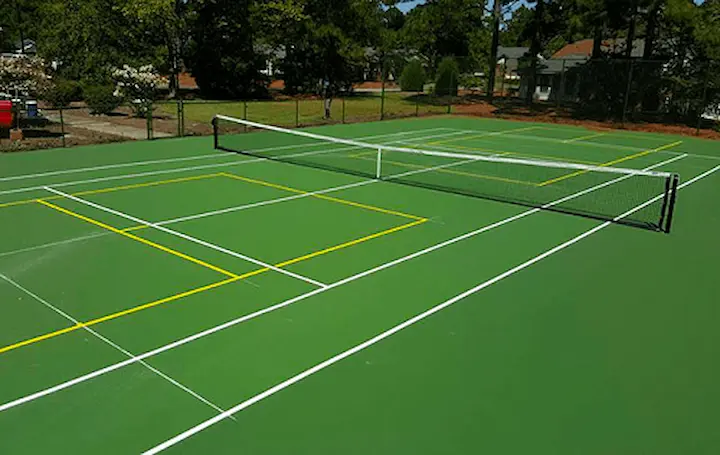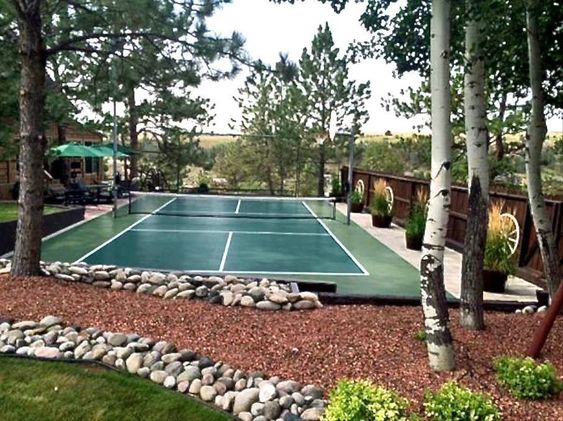Trick Aspects in the Construction of Pickleball Judiciaries: From Site Option to Final Coatings
The building of pickleball courts incorporates a series of critical aspects, beginning with the choice of an appropriate website that balances availability with environmental considerations. Essential aspects such as court measurements, surface products, and water drainage systems substantially influence not only the high quality of play yet also the longevity of the facility. Focus to lights and finishing touches can raise the total experience for players and spectators alike. Comprehending just how each of these components interrelates may expose understandings that are often ignored, motivating a more detailed evaluation of finest techniques in court building and construction.
Site Choice Requirements
When starting the building of pickleball courts, it is vital to toenail down the site choice criteria that will ensure optimal playability and accessibility. The area has to be conveniently obtainable for players, ideally positioned near houses or recreation center, to urge involvement.
In addition, the terrain should be level and stable, as uneven ground can lead to safety and security dangers and impact gameplay. Sufficient drainage is additionally essential; picking a site with good water drainage will help keep court conditions during damaging weather condition.
Another vital factor to consider is the accessibility of energies. Accessibility to electrical power and water is necessary for lights and maintenance objectives. Furthermore, proximity to parking centers is important, promoting simple access for gamers and spectators alike.
Ecological factors can not be ignored; natural color from trees can enhance gamer comfort, while exposure to dominating winds may interfere with play. Finally, zoning laws and neighborhood assistance ought to be taken into consideration to ensure that the job aligns with regional standards and receives the support it requires for successful execution. By very carefully evaluating these requirements, stakeholders can develop a welcoming and functional atmosphere for pickleball fanatics.
Court Capacities and Layout
To make sure optimum gameplay and adherence to regulations, the dimensions and layout of pickleball courts need to be meticulously specified. A basic pickleball court determines 20 feet in size and 44 feet in size for both songs and increases play. The advised layout includes a non-volley zone, typically referred to as the "kitchen area," prolonging 7 feet from the web on either side. This location is critical, as it affects gamer positioning and shot option - Illinois and midwest.
The web elevation is established at 36 inches at the sidelines and 34 inches at the center, producing a small dip that affects ball trajectory. Court markings are equally vital; lines need to be 2 inches vast and distinctive in shade to make sure exposure.
Additionally, a buffer zone bordering the court is a good idea, normally prolonging 5 to 10 feet beyond the sidelines and baselines to suit gamers' motions and enhance safety and security. Correct format and dimensions not only make certain conformity with official regulations yet likewise enhance the total having fun experience, accommodating both recreational and affordable play. Cautious planning in these locations is vital to the successful construction of pickleball courts.
Surface Area Material Options
Picking the ideal surface product for pickleball courts is important for ensuring optimum player efficiency and security. The choice of surface can considerably influence gameplay, including ball bounce, grip, and player convenience.
There are a number of options readily available, each with its distinct features. Asphalt is a prominent selection because of its durability and reduced maintenance demands. It provides a strong having fun surface area that can withstand different weather but might require regular resurfacing.
Concrete is another commonly used product, offering exceptional longevity and a smooth surface. It enables constant round bounce but can be hard on gamers' joints, making it much less preferable for long-lasting play without correct cushioning.
For those seeking boosted comfort and shock absorption, supported acrylic surfaces provide a viable option. These surface areas incorporate a base layer with an acrylic topcoat, offering enhanced grip and a softer feeling, which is useful for minimizing the threat of injuries.
Lastly, synthetic grass is getting grip, specifically for multi-purpose centers. Its versatility and lower maintenance needs make it an appealing choice, though it might not supply the very same round feedback as traditional hard courts. Careful consideration of these options will guarantee an optimal playing environment.
Drainage and Lighting Considerations
Proper water drainage and efficient lighting are essential parts in the building of pickleball courts, considerably affecting both playability and security. Adequate water check out this site drainage systems avoid water accumulation, which can lead to unsafe surfaces and damages to the court structure.
Illumination is similarly essential, particularly for courts intended for evening use. The placement of illumination components must be purposefully intended to eliminate shadows and provide even distribution of light across the court.

Last Coatings and Maintenance
After resolving water drainage and lights considerations, attention turns to the final coatings and recurring maintenance of pickleball courts. Illinois and midwest. The choice of surface material is crucial, as it influences both playability and durability. Usual options consist of acrylic coatings and specialized sporting activities surface areas that give optimum grip and cushioning. These finishes should be used in numerous layers to make certain durability against weather elements and put on.

Seasonal upkeep might include resurfacing every couple of years, depending on usage and ecological factors. Appropriately keeping nets, court lines, and bordering locations is equally essential to give a secure and pleasurable having fun experience. By buying quality surfaces and sticking to an organized upkeep schedule, facility owners can guarantee discover here their pickleball courts continue to be in excellent condition for many years ahead.
Verdict
In conclusion, the successful building of pickleball courts depends upon thorough attention to several essential aspects. Website option need to prioritize accessibility and terrain stability, while court dimensions and layout should adhere to ideal requirements for gameplay. The selection of surface area product dramatically affects gamer safety and security and efficiency. Furthermore, effective drainage and adequate lighting add to court longevity and presence. Lastly, high quality finishes and a durable upkeep schedule are important for maintaining the court's problem, boosting the general experience for gamers and viewers alike.